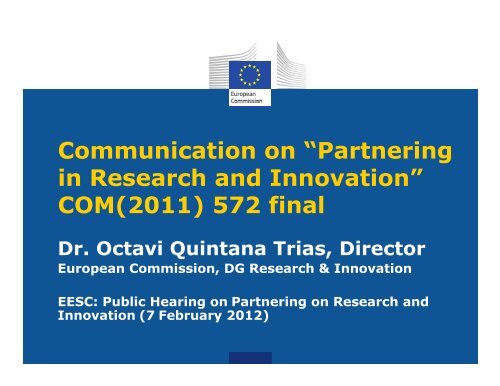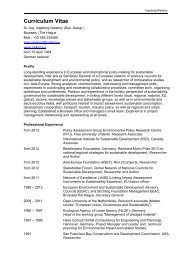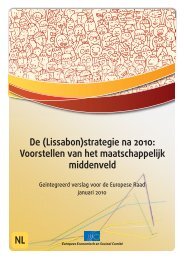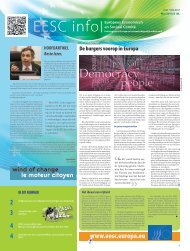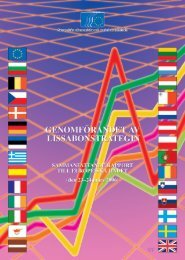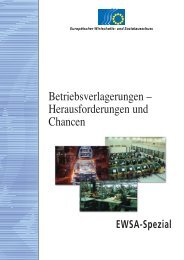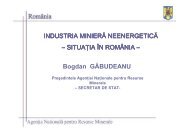EC DG RTD Mr Quintana Trias 7.2.2012
EC DG RTD Mr Quintana Trias 7.2.2012
EC DG RTD Mr Quintana Trias 7.2.2012
Create successful ePaper yourself
Turn your PDF publications into a flip-book with our unique Google optimized e-Paper software.
Communication on “Partnering<br />
in Research and Innovation”<br />
COM(2011) 572 final<br />
Dr. Octavi <strong>Quintana</strong> <strong>Trias</strong>, Director<br />
European Commission, <strong>DG</strong> Research & Innovation<br />
EESC: Public Hearing on Partnering on Research and<br />
Innovation (7 February 2012)
What is Partnering?<br />
Brings together Public players in P2Ps as well as public<br />
and Private players in PPPs to:<br />
• Build critical mass to ensure scale and scope;<br />
• Facilitate joint vision development and strategic agenda<br />
setting;<br />
• Pursue a programming approach;<br />
• Provide for flexible structures and arrangements.
Why we need Partnering?<br />
• Scarce public and private resources to fund research and<br />
innovation in Europe<br />
• Low level of coordination<br />
• Fragmentation and duplication<br />
• Need to address major challenges<br />
• Need to strengthen Europe's competitive<br />
position<br />
• New relationship with stakeholders as partners<br />
Example: Rare Diseases
ERA-NET on Rare Diseases:<br />
E-Rare<br />
• At least 6-8000 known rare diseases, affecting some<br />
29 million EU citizen<br />
• E-Rare from 2006 on: common European<br />
programme of 12 EU countries on rare disease<br />
research, 3 joint calls of € 10 million<br />
• Up to 40% of public research in this area now<br />
coordinated together with FP7 rare diseases related<br />
calls
Objectives of the Partnering Communication<br />
• Draw Lessons with regard to Public-Public Partnerships<br />
(P2Ps) and Public-Private Partnerships (PPPs)<br />
• Identify Steps to Improve Implementation of<br />
Partnering<br />
• Draw the initial lessons from the Active and Healthy<br />
Ageing pilot European Innovation Initiative and their<br />
implications for future EIPs<br />
• Fulfil Legislative Requests from Council
Levels of P2P<br />
Policy level<br />
Joint Programming addressing Societal Challenges<br />
SET Plan (European Energy Research Alliance)<br />
Programme level<br />
ERA-NET<br />
ERA-NET Plus<br />
Article 185 initiatives<br />
Europe INNOVA/PRO INNO Europe
Examples for P2Ps<br />
Joint Programming Initiative on<br />
Neurodegenerative Diseases: JPND<br />
• Recognised by MS as a major societal<br />
challenge- 23 EU countries involved<br />
• Pilot call (a total budget of<br />
€ 14 million)<br />
Article 185 Initiative on metrology<br />
(EMRP)<br />
• 44% of overall metrology resources in one<br />
initiative<br />
• Multiannual joint programme (over €400<br />
million)
Levels of PPPs<br />
Institutionalised PPPs<br />
Joint Technology Initiatives<br />
SESAR<br />
Contractual PPPs / Voluntary Agreements<br />
Recovery PPPs<br />
Future Internet<br />
COLIPA<br />
European Industrial Initiatives of the SET Plan
Examples for PPPs<br />
Clean Sky Joint Technology Initiative<br />
• New, environmentally-friendly aeroplanes<br />
• After 2,5 years of operation, the first flight tests<br />
carried out (€232 million)<br />
Factories of the Future PPP under the<br />
European Recovery Plan<br />
• New and sustainable manufacturing<br />
technologies (€ 1.2 billion)<br />
• A broad range of industrial stakeholders
Lessons learnt<br />
Ensure involvement of partners on long-term basis:<br />
MS: multi-annual financial commitments<br />
Need for public declaration by MS and industry leaders<br />
Article 185 Initiatives: Firm Commitments to Financial<br />
Integration<br />
Single, more Flexible ERA-NET Instrument<br />
Need for “ERA Framework” to Focus on Overcoming<br />
Obstacles (cross-border funding, knowledge circulation,<br />
open access)
Who benefits and how?<br />
• Citizens – through quicker access to products and<br />
services with the potential to significantly impact our lives<br />
• Scientists – through the opportunity to work with peers<br />
across Europe<br />
• Businesses – able to sell new products and services


